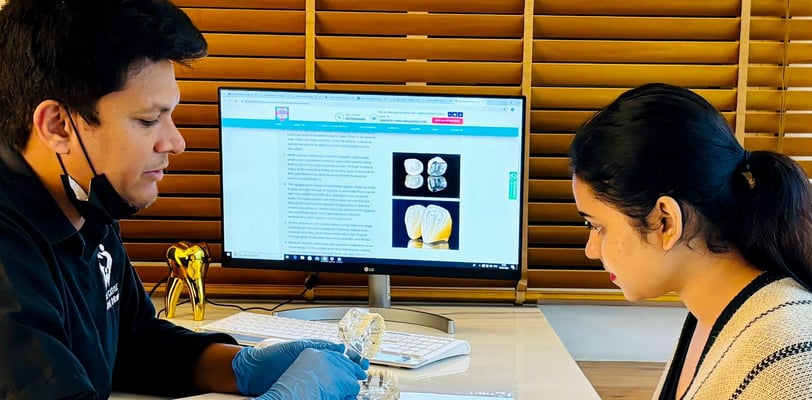Best Dental Clinic in Katraj White Castle Dental Clinic
Rooot Canal Treatment near me: Procedure, Necessity, and Aftercare
2/18/20254 min read


Understanding Root Canal Treatment
Root canal treatment is a crucial dental procedure designed to address issues within the pulp of a tooth. The pulp comprises nerves, blood vessels, and connective tissue, which can become infected or inflamed due to various factors such as deep tooth decay, repeated dental procedures, or trauma to the tooth. In situations where the pulp becomes compromised, a dentist may recommend a root canal to remove the infected tissue and preserve the integrity of the tooth.
A root canal procedure is not only essential for alleviating pain caused by infection but also serves as a means to prevent further complications. An untreated infected tooth can lead to abscess formation, which potentially results in chronic pain, swelling, and even systemic health issues if bacteria enter the bloodstream. Therefore, addressing these underlying conditions promptly is vital for maintaining both oral and overall health.
The benefits of undergoing a root canal treatment are manifold. One of the primary advantages is pain relief. Many patients who require this procedure experience severe discomfort; once the infected pulp is removed, they often report significant relief. Another critical benefit is the preservation of the natural tooth structure. Extracting a tooth can lead to adjacent teeth shifting, changes in bite alignment, and loss of bone density in the jaw. A root canal allows individuals to retain their natural teeth, focusing on long-term dental health.
In conclusion, understanding root canal treatment is essential for recognizing its necessity. By addressing issues like tooth decay or infection promptly, individuals can avoid more severe dental complications, ensuring their long-term oral health. This procedure not only alleviates pain but also plays a vital role in preserving natural teeth and preventing future dental challenges.
When to Visit the Dentist for a Root Canal
Recognizing the symptoms that necessitate a visit to the dentist for a root canal is crucial for maintaining oral health. One of the primary indications is a persistent toothache that does not subside. This pain may vary in intensity and can feel sharp or throbbing, often indicating that the dental pulp is inflamed or infected. It is essential to pay attention to the duration and severity of the pain, as ignoring it can lead to more severe complications.
Another common symptom to watch for is sensitivity to temperature changes, particularly hot or cold. If consuming hot beverages or ice-cold foods results in prolonged discomfort or sharp pain, it may signal an issue with the tooth's nerve. In this context, heightened sensitivity can suggest that the tooth requires professional evaluation and potential root canal treatment.
Swelling around the gums is another critical sign that indicates the need for dental intervention. If you notice swelling or tenderness in the gum tissue near a specific tooth, it may be a sign of infection that could necessitate a root canal procedure. Additionally, discoloration of the tooth—whether it appears darker or has an unusual hue—can indicate nerve damage or decay that warrants immediate attention.
Regular dental check-ups are vital in detecting potential problems before they escalate. Dentists can provide early intervention to prevent the need for more extensive treatments. If you experience any of the aforementioned symptoms—persistent toothache, sensitivity, swelling, or discoloration—it is imperative to seek prompt dental care. Early diagnosis and treatment can not only relieve pain but also save the affected tooth, allowing it to function normally for years to come.
The Root Canal Procedure: Step by Step
The root canal procedure is a dental treatment aimed at repairing and saving a tooth that is severely decayed or infected. This treatment typically involves several steps, beginning with a thorough examination conducted by the dentist. Diagnostic tests, such as X-rays, are performed to assess the extent of infection and to visualize the root canals' structure. Once the diagnosis is established, the dentist will discuss the treatment options with the patient, ensuring they understand the necessity of the procedure.
Before the root canal treatment begins, the area surrounding the tooth will be numbed using local anesthesia. This step is crucial in ensuring that the patient remains comfortable throughout the procedure. Once the area is adequately anesthetized, the dentist will create an opening in the crown of the tooth to access the pulp chamber, which contains the affected nerve tissue, blood vessels, and connective tissue.
Using specialized instruments, the dentist meticulously cleans out the infected or damaged pulp from the root canals. This process can take some time, as it is essential to remove all of the infected tissue to prevent future complications. Following the cleaning, the dentist will disinfect the canals and may fill them with a biocompatible material to prevent reinfection. After this initial cleansing, the tooth will usually be sealed temporarily to allow for proper healing.
Typically, the root canal treatment may require one to three visits, depending on the severity of the infection and the complexity of the tooth's root structure. During each visit, further evaluations will be made to ensure that the treatment is progressing satisfactorily. Technological advancements, such as digital X-rays and rotary endodontics, have significantly improved the efficiency and comfort of root canal procedures, leading to a more positive experience for patients.
Aftercare Following a Root Canal: Tips and Recommendations
After undergoing a root canal treatment, proper aftercare is crucial to ensure a smooth recovery and safeguard the health of your tooth and surrounding gums. Patients may experience some discomfort and sensitivity post-procedure, which is usually manageable with over-the-counter pain relief medication, such as ibuprofen or acetaminophen. It is advisable to follow the dosage instructions provided by your dentist, and if the pain persists or worsens, reach out to your dental professional immediately.
Dietary choices can significantly impact your recovery. In the initial days following the procedure, it is recommended to stick to a soft food diet. Foods such as yogurt, mashed potatoes, soups, and smoothies can be both nourishing and easy on your mouth. Additionally, avoiding hard, crunchy, or sticky foods will reduce the risk of damaging the treated tooth while it is still healing. Be cautious with temperature variations, as extremely hot or cold foods and beverages may amplify sensitivity.
Maintain good oral hygiene throughout your recovery process. Continue to brush your teeth gently, being careful not to disturb the treated area. Flossing should be continued, but again, it is vital to be gentle around the tooth that has been treated. Your dentist may recommend a specific mouthwash to use during this period to prevent infection and promote healing.
Finally, the importance of attending follow-up appointments cannot be overstated. These visits are essential for monitoring the healing process and determining if further restorative procedures, such as permanent crowns, are needed. If any unusual symptoms, such as prolonged pain, swelling, or discharge occur, it is imperative to contact your dentist promptly. Remember, being well-informed and proactive can significantly enhance your recovery experience.
